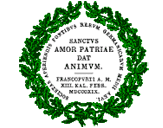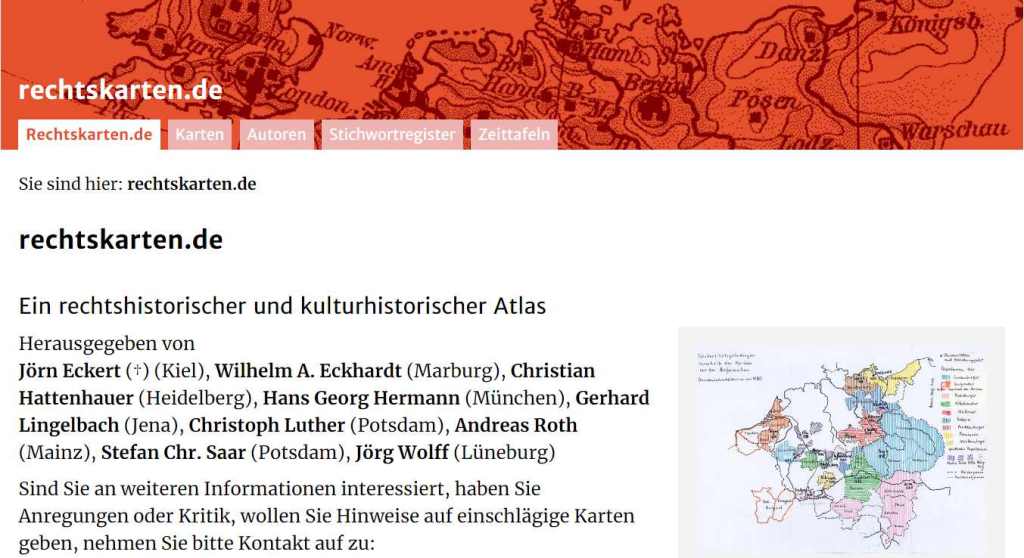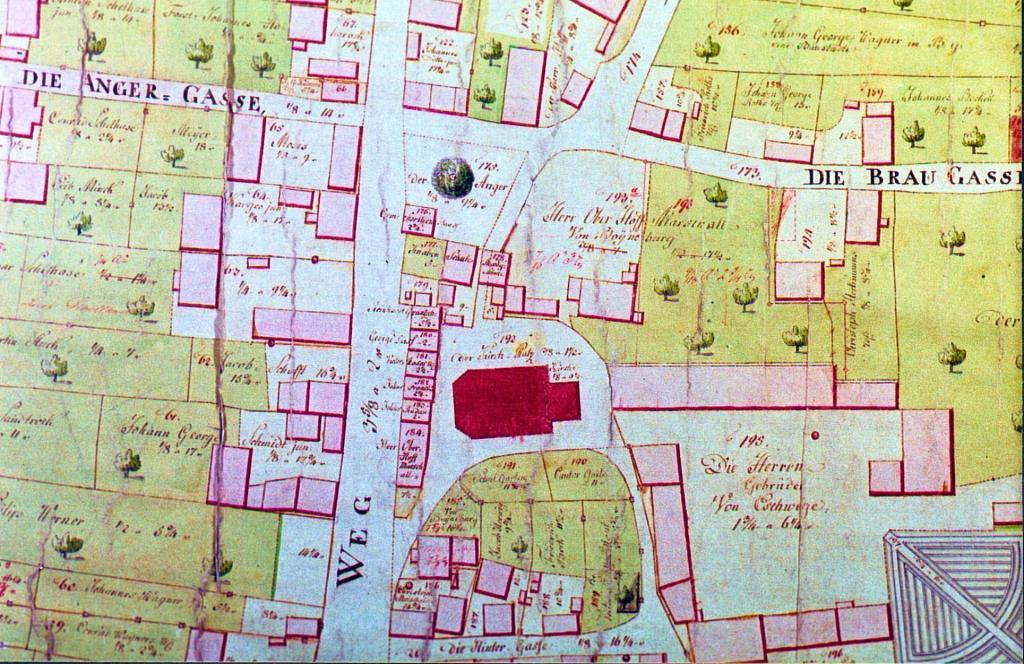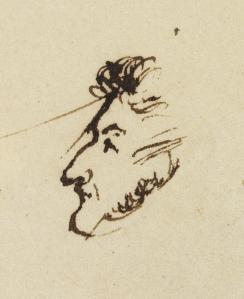 Every year some subjects and themes are brought to your attention just because there is some jubilee or centenary. In the face of their sheer number I wisely do not venture to trouble you with all centennial or even bicentennial celebrations. For me the Monumenta Germaniae Historica are exceptional in many ways. In view of the scholarly impact on the field of medieval history, German and European history, and in particular many fields of legal history. A meeting in Frankfurt am Main on January 20, 1819 has had a very important influence on the shaping of history as a scholarly discipline taught at universities. The flow of editions produced in two centuries is one thing to marvel at, but the story of this institution is much richer. Some celebrations have already been held in January, but the last week of June 2019 has been chosen as the week with more events around this bicentenary. I will try to be as concise as possible, but the story of the MGH deserves space!
Every year some subjects and themes are brought to your attention just because there is some jubilee or centenary. In the face of their sheer number I wisely do not venture to trouble you with all centennial or even bicentennial celebrations. For me the Monumenta Germaniae Historica are exceptional in many ways. In view of the scholarly impact on the field of medieval history, German and European history, and in particular many fields of legal history. A meeting in Frankfurt am Main on January 20, 1819 has had a very important influence on the shaping of history as a scholarly discipline taught at universities. The flow of editions produced in two centuries is one thing to marvel at, but the story of this institution is much richer. Some celebrations have already been held in January, but the last week of June 2019 has been chosen as the week with more events around this bicentenary. I will try to be as concise as possible, but the story of the MGH deserves space!
History, nationalism, Romanticism

The start of the project we now know as the Monumenta Germaniae Historica happened in a particular time and place. Horst Fuhrmann analyzed concisely in his splendid book on the scholars of the MGH the start of this enterprise and much more, and I follow here his lead [Sind eben alles menschen gewesen. Gelehrtenleben im 19. und 20. Jahrhundert. Dargestellt am Beispiel der Monumenta Germaniae Historica und ihrer Mitarbeiter (Munich 1998; online, MGH (PDF))]. After the dissolution of the Holy Roman Empire in 1803, according to the late Peter Landau more important in Germany’s history than the reforms created by Napoleon, after the Napoleonic wars and the establishment of a new political order in Europe at the Congress of Vienna (1814-1815) there was time in Germany to look backwards. You would assume that a number of people influenced by Romanticism founded the Gesellschaft für ältere deuttsche Geschichtskunde. the society for the study of older German history, but Lorenz vom Stein (1757-1831) and his visitors were not the archetypical romantics. This lawyer and former Prussian minister met at Frankfurt am Main with four delegates of the Bundestag, the central organ of the Deutsche Bund (1815). Vom Stein was known for his proposals for reforming public law and administration. Instead of looking back at the past he wanted to work to rebuild and strengthen Germany as a nation. The project originally set out to publish a number of sources in a relatively short time span, maybe ten years. Vom Stein had been in contact with leading German romantics to ask for their opinion and support.
In the first years the project met with some approval but also with indifference, criticism and even derision. Metternich subjected the first volumes to censorship. One of the ironies was the fact a team of students was sent to Paris to copy medieval manuscripts, because they were more bountiful and better accessible in the French capital than in other major libraries. The German states did not want to put money into the MGH. An offer for funding the project came not from German politicians, but from the Russian tsar. Vom Stein politely declined and spend a lot of his own money. In 1820 an accompanying journal was started, the Archiv für ältere deutsche Geschichtskunde, the ancestor of the current Deutsches Archiv für Erforschung des Mittelalters. From 1823 onwards an archivist from Hannover, Georg Heinrich Pertz (1795-1876), led the small team around Vom Stein. He designed the division of the editions into five major series, the Scriptores for editions of works dealing with history, the Leges with legal resources, the Epistolae for letters, the Diplomata for charters, and the Antiquitates for other sources. Pertz stayed with the Monumenta for fifty years.
Fuhrmann, himself a former president of the MGH, was quite right in writing a story about scholars as people, ordinary mortals with great gifts and sometimes wilful personal characteristics. The strife between Pertz and Georg Waitz (1813-1886) was not only a matter of different visions of history and scholarly practices, an archivist developing on his own the historical-critical method to edit sources against a scholar trained by Ranke, but also a clash of two humans. Some projects stemming from the MGH belong to the Vorarbeiten, preliminary works such as the Regesta Imperii started by Johann Friedrich Böhmer who later on after quarrels with the MGH decided to edit a series Fontes rerum Germanicarum (4 vol., Stuttgart 1843-1868). Others, too, had their trouble with the MGH and started their own series. Philipp Jaffé edited after his break with Pertz the series Bibliotheca rerum Germanicarum (6 vol., Berlin 1864-1873). Thus the MGH delivered not only its editions, but set path-breaking examples of using the historical-critical method. It became a model for projects abroad by the very fact they initially stuck to just publishing sources, not scholarly monographs. Controversies about its role and aims led to other important scholarly projects in the field of medieval history.
A human history
With Philipp Jaffé (1819-1870) we encounter perhaps the most tragic of all Monumentisten. Jaffé had studied in Berlin, and without getting a Ph.D. he started his own projects. The first edition of his Regesta pontificum Romanorum, a work listing 11,000 papal acts and charters up to 1198, appeared in 1851. In these years he studied medicine in Berlin and Vienna, believing he had no chance to make a career as an historian being a Jew. However, Ranke considered Jaffé his very best student and made him the first ausserplanmässiger professor in all Germany. Between 1854 and 1862 he worked for the MGH. On the title pages of the six volumes of the Scriptores series Jaffé helped editing his name was not mentioned. In 1863 a feud developed between him and Pertz, who eventually wanted to deny him access to the Staatsbibliothek in Berlin. Jaffé started his own series with major source editions. He got estranged from his family, converted to Lutheranism, and in growing isolation he took his life in 1870, a fact that shocked the scholarly world.
It is impossible to follow here the MGH and its contributors through all its history, if only for the sheer number of scholars for which you can find photographs at the MGH website. Jews had indeed a great role for the published editions. In particular Harry Bresslau, the author of the Geschichte der Monumenta Germaniae Historica (Hannover 1921; reprint 1976; online, MGH) felt hurt under antisemitic attacks. During the period of the Third Reich Ernst Perels and Wilhelm Levison were among the targets of the Nazi regime. The MGH became a Reichsinstitut für ältere deutsche Geschichtskunde, but Nazi control was not total. In 1939 Levison could find a refuge in Durham. In 1944 the MGH had to leave Berlin for Pommersfelden near Bamberg. In 1949 the institute came to Munich where the MGH found in 1967 its current location in the main building of the Bayerische Staatsbibliothek. You can find the titles of the MGH’s own publications about its history on this web page.
The library collection of the MGH is now famous for its riches, but it was only after getting in 1907 the books of Ludwig Traube and in 1911 those of Oswald Holder-Egger a substantial library came into existence [see Norbert Martin, ‘Die Bibliothek der Monumenta Germaniae’, Bibliotheksforum Bayern 19/3 (1991) 287-294]. One of the special qualities of the online catalogue is the presence of links to reviews of works in the Deutsches Archiv. Nowadays we may take dMGH, the digital MGH, for granted, but such projects are solely possible with financial means and other support by institutions as for example the Bayerische Staatsbibliothek and the Deutsche Forschungsgemeinschaft (DFG). The MGH have a legal status under public law as an institution for the Freistaat Bayern with subventions by other Bundesländer. I have been fortunate to work in 1997 and 1998 with the library staff of the MGH, and my fond memories of these days prompt me to write here, too. Apart from the vast collection with printed books on the history of medieval Europe the Virtueller Lesesaal offers a lot of books in several sections. Here I would like to single out the digital version of Paul Oskar Kristeller’s Latin manuscript books before 1600. A list of the printed catalogues and unpublished inventories of extant collections (4th edition, 1993; supplement, 2006; revised digital edition 2016). This indispensable guide has been revised and updated by Sigrid Krämer and Birgit Christine Arensmann.
A mighty enterprise
The time with just five massive series of editions is long ago, a mighty fleet of series has sailed into our century. The Monumenta Germaniae Historica in its printed form take many shelves in a library and make a mighty impression. In the early eighties the very stacks with the folio volumes of the MGH collapsed in the rather new library of the history department in Utrecht, luckily before opening hours. Apart from a library catalogue you might better use the yearly leaflet with an overview of the editions which duly was posted near these stacks. The Gesamtverzeichnis 2019 is also available online (PDF). In 1997 even the library of the MGH decided to catalog again all editions since 1826.
Legal historians will within the old series and the current program of edition projects first of all turn to the Leges and Diplomata series. In the Leges series there are currently projects for sources such as the Collectio Gaudenziana (Wolfgang Kaiser), the Collectio Walcausina (Charles Radding), a part of the Leges Langobardorum, capitularies, formulae, and even for the most intriguing and difficult corpus of Pseudo-Isidorian decretals, just one example of a project which cannot be seen properly without looking to other forged collections around it. More soberly it is also an example of a project running over many decades. If you remember Antonio Agustín’s reluctance in the late sixteenth century to pronounce a clear verdict, a forgery or genuine material, even though he was in the best position to do this, you will understand the courage of scholars such as Horst Fuhrmann, Schafer Williams, Klaus Zechiel-Eckes and now Eric Knibbs to proceed in their wake with finally producing a critical text edition. Among other projects in this series are editions of medieval councils, a new edition of Regino of Prüm, royal constitutions, the glosses to the Sachsenspiegel, and the Latin version of an other treatise on German law, the Schwabenspiegel. It is good to see here attention for several kinds of legal systems
The publications within the Diplomata series may seem more straightforward. The sheer mass of charters issued from the Carolingian period onwards is indeed much greater than one could calculate in the first half of the nineteenth century. Nowadays not only charters of kings and emperors are being edited, volumes for some princes have appeared, too, and also for the Latin kings of Jerusalem. For the charters of the emperors Henry V and Henry VI there is even a digital pre-edition online, for the latter only for German recipients. Dieter Hägemann and Jaap Kruisheer, assisted by Alfred Gawlik, edited the two volumes of Die Urkunden Heinrich Raspes und Wilhelms von Holland (2 vol., Wiesbaden 1989-2006) with the charters of the only Roman king from the Low Countries. It is also the only case in which a Dutch scholar worked on a volume published for the MGH.
As for the newer series it is sensible to look here at just three series. In the series MGH Hilfsmittel we find works such as Uwe Horst, Die Kanonessammlung Polycarpus des Gregor von S. Grisogono. Quellen und Tendenzen (Wiesbaden 1980), the Wortkonkordanz zum Decretum Gratiani, Timothy Reuter and Gabriel Silagi (eds.) (5 vol., Wiesbaden 1990), the monograph of Rudolf Pokorny and Hartmut Hoffmann, Das Dekret des Bischofs Burchard von Worms. Textstufen – Frühe Verbreitung – Vorlagen (Wiesbaden 1991), and the printed edition of Linda Fowler-Magerl, Clavis Canonum. Selected canon law collections before 1140 (2005). Her work is now available online in a database with a German and English interface. Danica Summerlin and Christoph Rolker have added new canonical collections to the database.
The series Schriften der Monumenta Germaniae Historica is one of the oldest series to supplement the original program. You can choose at will in this series for classic studies. I mention here for legal history Arno Borst, Die Katharer (Stuttgart 1953), Horst Fuhrmann, Einfluß und Verbreitung der pseudoisidorischen Fälschungen von ihrem Auftauchen bis in die neuere Zeit (3 vol., Stuttgart 1972-1974), the six volumes of the congress Fälschungen im Mittelalter (6 vol., Stuttgart 1988-1990), Harald Siems, Handel und Wucher im Spiegel frühmittelalterlicher Rechtsquellen (Stuttgart 1992), and Maike Huneke, Iurisprudentia romano-saxonica. Die Glosse zum Sachsenspiegel-Lehnrecht und die Anfänge deutscher Rechtswissenschaft (Wiesbaden 2014).
Within Studien und Texte, the third series which I like to mention, you will find indeed both source editions and monographs, such as Stephan Beulertz, Das Verbot der Laieninvestitur im Investiturstreit (Wiesbaden 1991), and Sascha Ragg, Ketzer und Recht. Die weltliche Ketzergesetzgebung des Hochmittelalters unter dem Einfluß des römischen und kanonischen Rechts (Wiesbaden 2006), the first of a number of recent volumes in this series with studies and editions concerning medieval inquisitions. For your convenience I refer to the page on medieval legal procedure of my legal history website where I have included these works.
Time to celebrate
 In its long and illustrious history the Monumenta Germaniae Historica had to deal with many crises and decisive moments. Think only of the 1880 fire in the house of Theodor Mommsen in Charlottenburg which destroyed working materials of the Monumenta, his personal library and some precious manuscripts in his custody! Remember the periods with a stifling political climate in the dark times of the Nazi regime. During the Second World War some materials were stored in a mine which was destroyed in 1945. Many projects suffered setbacks when editors failed to do their jobs properly, when death came too soon for experts dealing with most difficult matters, or clashes happened between scholars. The presidents and the Zentraldirektion have to steer between many rocks. Sometimes the presence of particular scholars is most helpful. From my own period I cherish the memory of Reinhard Elze, former director of the Deutsches Historisches Institut in Rome, who walked each day from his home to the MGH in the Ludwigstrasse. I think his steady rhythm and kind presence helped everyone in a way to stay focused and open to people and ways to solve problems of any kind. The funny poster makes me remember the way Horst Fuhrmann could make jokes and show his happiness.
In its long and illustrious history the Monumenta Germaniae Historica had to deal with many crises and decisive moments. Think only of the 1880 fire in the house of Theodor Mommsen in Charlottenburg which destroyed working materials of the Monumenta, his personal library and some precious manuscripts in his custody! Remember the periods with a stifling political climate in the dark times of the Nazi regime. During the Second World War some materials were stored in a mine which was destroyed in 1945. Many projects suffered setbacks when editors failed to do their jobs properly, when death came too soon for experts dealing with most difficult matters, or clashes happened between scholars. The presidents and the Zentraldirektion have to steer between many rocks. Sometimes the presence of particular scholars is most helpful. From my own period I cherish the memory of Reinhard Elze, former director of the Deutsches Historisches Institut in Rome, who walked each day from his home to the MGH in the Ludwigstrasse. I think his steady rhythm and kind presence helped everyone in a way to stay focused and open to people and ways to solve problems of any kind. The funny poster makes me remember the way Horst Fuhrmann could make jokes and show his happiness.
The program for the jubilee contained events in Berlin and Vienna in January, the festivities of last week in Munich, and a symposium to be held at the DHI in Rome on November 28-29, 2019 on “Das Reichsinstitut für ältere deutsche Geschichtskunde 1935 bis 1945 – ein “Kriegsbeitrag der Geisteswissenschaften”? [The research institute of the Reich for the study of older German history, 1935-1945. A war contribution of the humanities?]. The DHI and the MGH were forced to merge in 1935. What impact did the control of the Reich have, and not only for substantially widening the budget? On June 28 a discussion panel rightly stressed the international character of the MGH has today. In 1947 the MGH for the first time elected corresponding fellows, then and ever since from abroad. The flyer for this event shows a list with more than fifty scholars from Europe, the USA and Japan. The main scholarly meeting on June 28 and 29 dealt with the theme Quellenforschung im 21. Jahrhundert [Research on sources in the 21st century].
What laurels does the MGH need? The founders put a crown of oak leafs around the motto in Latin which defies translation, but inspiration and labor of love is the very heart, not only the forests of medieval Germany. Using the older volumes with the introductions in Latin, slowing down your reading speed to digest the wealth of information in the double apparatus of the annotation, checking the Deutsches Archiv for thorough articles, concise information about new works, and the yearly messages of the Zentraldirektion on the progress of editions in preparation, looking at the website for new books in the holdings of the MGH which you might want to use yourself, too, you realize the contributors to the MGH put all their talents into helping to create sure foundations for research, Grundlagenforschung. They challenge you to do your own tasks in a similar dedicated way. Let’s hope the staff and fellows of the MGH can continue to work for the community of scholars in the fields of medieval law and history!



 It seems difficult these weeks at my blog to leave Frankfurt am Main for other locations. The news about the death of Michael Stolleis on March 18, 2021 cannot be passed over here in silence, and thus again Frankfurt comes into view. Some obituaries succeeded very well in showing Stolleis’ role and achievements, and therefore I will not try to repeat everything already said with eloquent words.
It seems difficult these weeks at my blog to leave Frankfurt am Main for other locations. The news about the death of Michael Stolleis on March 18, 2021 cannot be passed over here in silence, and thus again Frankfurt comes into view. Some obituaries succeeded very well in showing Stolleis’ role and achievements, and therefore I will not try to repeat everything already said with eloquent words.



















